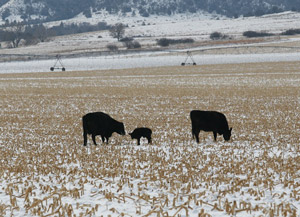Calving Cows on Cornstalks – Nutritional Considerations
March 2016

Calving season is getting underway and many producers choose to calve out on cornstalk fields. Residue fields can be a good place to maintain cowherds until cool season grasses are available but often times, calving occurs during February and March to avoid the busy farming responsibilities later in the spring.
Lactation begins while the cows are on low quality forage (50% total digestible nutrients or TDN) and supplying 2-2.5 lb of a 20% crude protein supplement will only provide the cow with about 13 lb of TDN per day. Once lactation occurs a 1200 lb cow will need about 15-16 lb of TDN. If enough residue still exits for the cows to consume 27-28 lb per day, then supplementing with approximately 5 lb (as is basis) of dried distillers grains could provide the needed 15 lb of TDN.
Using the residue field simply as a feeding area, a producer could feed approximately 28 lb of alfalfa hay (about 58% TDN, 18% CP) and 3 lb of corn on an as is basis and provide 15 lb of TDN as well.
Knowing the amount of residue available is important. Also, producers need to keep in mind that once the cows start selecting the highest quality residue, the TDN available decreases. The best quality residue is the husks and leaves and what residual corn the cows can find. The stalks are poorer quality (only about 35% TDN) and are not selected by the cattle until the more desirable parts are gone.
There is a very helpful formula to help producers estimate how long a field should be grazed. There are about 16 lb of good quality residue dry matter produced for each bushel of grain produced. Only about half of that is available to the animal because it gets trampled, soiled, or blows away. So if a field produced 200 bushels of corn per acre, then there is about 1600 lb of good quality residue on a dry matter basis available per acre (200*8). If the 1200 lb lactating cow and her new calf are going to need about 29 lb of dry matter per day, then one acre should last them approximately 55 days. This is an estimate for stocking guidelines and can be impacted by weather, size of the cow, age of the calf, and other factors.
Conclusion
Cornstalk residue utilization is a great way for producers to integrate crops and livestock. Maintaining cows on residue can be an economical choice, but additional feed costs will be necessary when calving on residues and lactation increases the energy demands of the cow.
For more information on meeting the nutritional needs of the cow see NebGuide G2268 Supplementation Needs for Gestating and Lactating Beef Cows and Comparing the Prices of Supplement Sources (PDF version, 976KB) or visit the Cow-calf, Bull and Heifer Nutrition and Management page.
Karla H. Jenkins
UNL Cow/Calf, Range Management Specialist